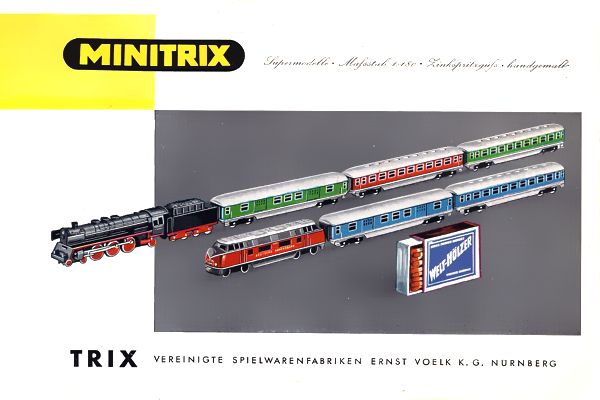
All About Aurora Postage Stamp Trains
Part 1: Beginnings & Introductions
A Very Brief History of N Scale
For the uninitiated, it may be helpful to provide some context for Postage Stamp Trains with an overview of N Scale's formative years. (For significantly more detail on the early years of the scale, see my sister website, The Birth of N Scale.)
Although there were some toys of N Scale-ish proportions made as early as 1912, the scale got a solid foothold around 1957 when Lone Star Toys of England introduced a line of tiny die-cast metal push-along toys. Treble-0, or 000, is described as 2mm to the foot, which is quite close to modern N Scale (1:152 versus 1:160, although there is some contention over the actual scale of Lone Star's models).

In 1960, Lone Star then launched Treble-0-Lectric, the world's first mass-produced electrically-powered N Scale model trains, as reported in a British toy fair report. Two years later the product line comprised over 160 items, and even included some North American trains.


Unfortunately, the drive mechanism utilized rubber bands—hence the warning about never oiling—and between poor performance and stiff new competition, the line was doomed. Evidently, a large stockpile of products remained unsold after Lone Star went bankrupt.
Meanwhile, Trix Modelleisenbahn GmbH & Co. KG of Nürnberg had been competing with Lone Star's push-along line since 1957—at a scale of 1:180—and was in the process of developing electrically-powered N Scale trains when Karl Arnold & Co, also of Nürnberg, beat them to the punch by creating their own new line of N Scale electric trains in 1960.
Originally called Rapido 200—with a scale of 1:200—the products were quite crude, not even as good as Lone Star's toys; Treble-0-Lectric trains at least had functional couplers, whereas Arnold just had C-shaped metal hooks. Locos ran on 6 VDC instead of the usual 12. Incidentally, original Rapido 200 cars command prices far in excess of comparable products, often between $50 and $100 per car.
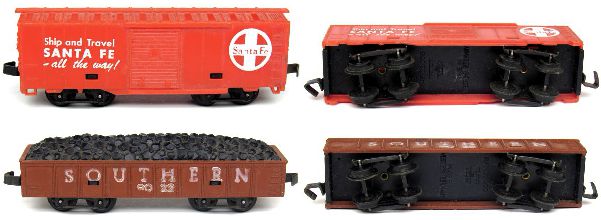
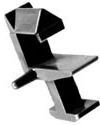 After changing to 1:160, Arnold quickly improved their
products and began making some very savvy business decisions, one of them being to permit other model manufacturers to use their new coupler design—based on a
TT Scale coupler licensed to them by Rokal
(highlighted below)—which helped to grow the market rapidly. Thus the ubiquitous "Rapido coupler" (right) then became the worldwide standard. In addition, Arnold
established many other standards to ensure interoperability across the industry, something that had been lacking in larger scales at that time.
After changing to 1:160, Arnold quickly improved their
products and began making some very savvy business decisions, one of them being to permit other model manufacturers to use their new coupler design—based on a
TT Scale coupler licensed to them by Rokal
(highlighted below)—which helped to grow the market rapidly. Thus the ubiquitous "Rapido coupler" (right) then became the worldwide standard. In addition, Arnold
established many other standards to ensure interoperability across the industry, something that had been lacking in larger scales at that time.

Trix followed right on the heels of Arnold, unveiling in 1964 what was arguably a technically and aesthetically superior product line under the brand name "Minitrix Electric." Trix later partnered with Roco in Austria to create an impressively accurate (for the day) line of rolling stock.
By 1967 the market was truly burgeoning: dozens of European manufacturers were busily churning out all manner of trains and accessories. While it would still be a few years before N Scale manufacturing caught on in the United States, several US companies were quick to start importing it—particularly since, by then, many European manufacturers were making North American models (including Lima, Rivarossi and Röwa, to name a few). One such importer was Aurora Plastics Corporation of Long Island, New York.
Introducing Postage Stamp Trains
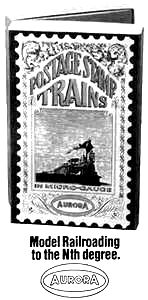 In 1967, Aurora arranged with Trix
to import their growing Minitrix line of North American N Scale model trains, along with track and
accessories, under the brand name Postage Stamp Trains. The name was chosen to emphasize the small size of "N Gauge," which Aurora chose
instead to refer to as "Micro-Gauge."
In 1967, Aurora arranged with Trix
to import their growing Minitrix line of North American N Scale model trains, along with track and
accessories, under the brand name Postage Stamp Trains. The name was chosen to emphasize the small size of "N Gauge," which Aurora chose
instead to refer to as "Micro-Gauge."
Aurora later fleshed out the product line with a nice assortment of bridge and building kits from Faller of Germany. Aurora even added Faller's new N Bus System (part of their enormous AMS slot car line), which was designed to integrate with N Scale trains, although the buses were closer to TT Scale in size out of necessity. Since Aurora was the slot car market leader at the time, and was even supplying Faller with some of their AFX cars, this seemed a natural arrangement.
Unfortunately, the timing was bad because Aurora was about to begin its death spiral, and consequently Postage Stamp Trains disappeared from the market by the end of 1973, suffering fits and starts along the way. Yet there's a silver lining to the premature demise of Postage Stamp Trains: because it was so short-lived, the line since caught the attention of collectors. Sets in particular are highly prized, and can fetch hundreds of dollars—ironic given that the product line wasn't particularly profitable for Aurora.
 Regardless of how short-lived the line may have been, what cannot be denied
is the indelible mark Aurora made on N Scale, now the second-most popular model railroading scale behind HO. A majority of N Scale modelers still recognize the brand name,
and many got their start in the scale with a Postage Stamp train set—myself included.
Regardless of how short-lived the line may have been, what cannot be denied
is the indelible mark Aurora made on N Scale, now the second-most popular model railroading scale behind HO. A majority of N Scale modelers still recognize the brand name,
and many got their start in the scale with a Postage Stamp train set—myself included.
For much more insight into the birth of Postage Stamp Trains, read a chapter written by Thomas Graham from an unpublished book, Aurora Games and Toys.
Who Was First in the US?
A number of websites and publications (example) claim that Aurora's Postage Stamp Trains marked the debut of N Scale in North America. This is totally incorrect. The PST line was probably more memorable because Aurora marketed it aggressively, targeting the general public instead of just hobbyists; however, PST was hardly the first, and in fact it was more of an also-ran, in the grand scheme of things. Let's take a closer look at N Scale's arrival in the US...
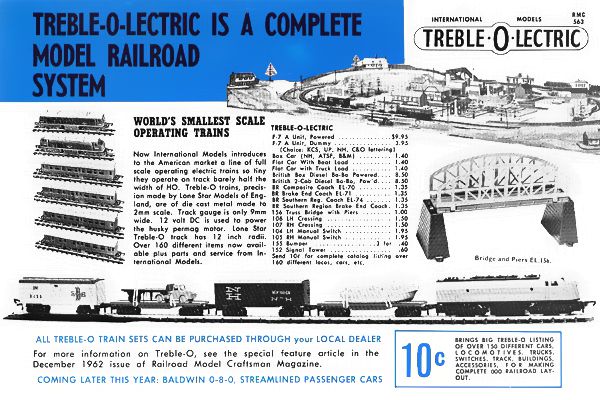
International Models Inc. and Montgomery Ward had both started importing Treble-0-Lectric into the United States as early as 1962; the line first appeared in Railroad Model Craftsman December of that same year. Some modelers don't recognize Treble-0-Lectric as a legitimate member of N Scale's history since they were 1:152 "toys" instead of 1:160 "models." No matter...
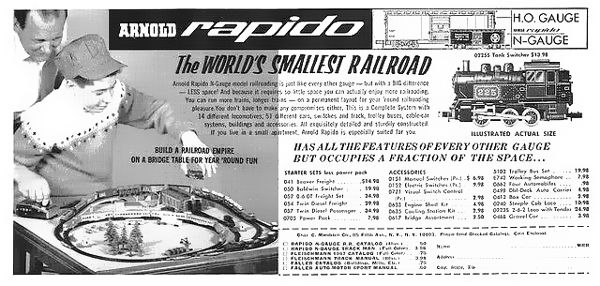
Charles C. Merzbach Company Inc. of New York City began importing Arnold Rapido as early as 1963 (they also imported Kibri and Faller structures beginning in 1966). Merzbach was Arnold's official US agent until 1967, when Revell took over the line; incidentally, Revell partnered with Arnold to expand and improve their North American product range.
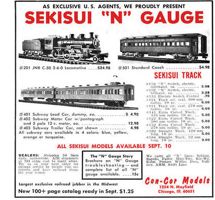 In 1966, Con-Cor began
importing Sekisui Knizoku (now known as Kato) Japanese N Scale trains, along with some Lima and
Röwa items; owner Jim Conway soon began commissioning Sekisui to produce North American models. Peco launched their high-quality
line of 9mm track that same year, which was imported into the US by Nathan R. Preston of Chicago. Then there was Atlas Tool Company in
New Jersey, who entered the market in 1967. Atlas chose to partner with Rivarossi in Italy for locomotives and passenger cars,
Roco for freight cars, Pola for structures (with a few Faller kits thrown in), and even Preiser
for figures! Atlas also aggressively expanded their product line well beyond the scope of Aurora's.
In 1966, Con-Cor began
importing Sekisui Knizoku (now known as Kato) Japanese N Scale trains, along with some Lima and
Röwa items; owner Jim Conway soon began commissioning Sekisui to produce North American models. Peco launched their high-quality
line of 9mm track that same year, which was imported into the US by Nathan R. Preston of Chicago. Then there was Atlas Tool Company in
New Jersey, who entered the market in 1967. Atlas chose to partner with Rivarossi in Italy for locomotives and passenger cars,
Roco for freight cars, Pola for structures (with a few Faller kits thrown in), and even Preiser
for figures! Atlas also aggressively expanded their product line well beyond the scope of Aurora's.
By 1968, Atlas, Aurora, Con-Cor and Revell had been joined by AHM, Bachmann and a host of others; the market became very crowded very quickly.
